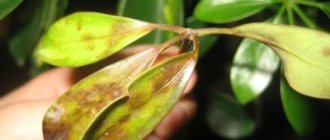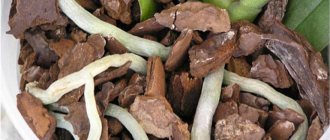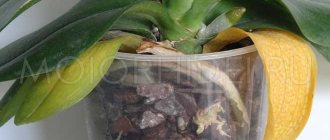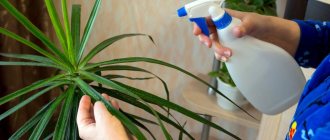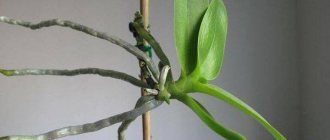Types of pigmentation
Pigmentation can be distinguished by several types of characteristics:
- size (there may be absolutely unnoticeable spots, which at a long distance in large numbers appear to be one large spot, and sometimes very large inclusions appear);
- color (all shades of yellow, brown, dark and black are found);
- shape (most often these are round spots, but the edges are not always smooth; they can be smooth, convex or, conversely, concave).
What do lesions look like?
On some sites, the manifestation in question is called “pigmentation.” This definition is completely incorrect. The spots that form on the leaves of the phalaenopsis orchid are always necrosis, that is, local tissue necrosis.
They happen:
- dark (brown, brown, black or even purple);
- light (whitish, yellow, red).
The spots vary in size. Sometimes these are small dots, and often they are large lesions of a regular round shape or lack clear boundaries.
Some lesions look like blisters, others, on the contrary, seem to be depressed. They are usually moist and sticky, and less often they are completely dry.
Where do they appear?
In principle, there is no part of the phalaenopsis where a speck could appear. However, they are most regularly found on the leaves.
It’s worse when the lesions spread through the root system. Here it is almost impossible to detect them in a timely manner.
In the latter situation, the presence of a problem is indicated only by the unhealthy appearance of the orchid and its slow withering.
Photo
You will see a photo of black and other dots on the flower:
Viral infections of phalaenopsis leaves
Of the viral infections, phalaenopsis most often suffers from leaf mosaic. The disease is provoked by different strains and mutations of the orchid mosaic virus. It appears in the form of chaotically located yellow spots with blurred edges, moving dark green depressed spots.
Unfortunately, there are no treatments for viral infections. And since they are contagious and can destroy the entire collection of orchids, diseased plants must be destroyed.
Viral infections are introduced to phalaenopsis mainly by insect pests. Therefore, timely destruction of aphids and other sucking parasites is the basis for the prevention of viral diseases.
Which inclusions are dangerous and which are not?
It is very difficult to say exactly what is dangerous for a plant. However, most often, if the inclusions are barely noticeable (small in size or the color of the pigmentation is not very different from the phalaenopsis area), this indicates that they are most likely not a cause for concern.
Reference! It's important to keep an eye on these types of spots because they can develop into something more serious. The main thing is to notice changes in time and take measures to eliminate them.
Fungal infections of phalaenopsis leaves and their treatment
The most common group of infections in orchids is fungal. Phalaenopsis can be affected by a large number of fungi, most of which settle on the leaves. Treatment of fungal infections is carried out using fungicidal drugs:
| Disease | Symptoms | Drugs for treatment |
| Fusarium | Softening and deformation of the leaf, development of weeping spots and a pinkish coating. | “Fundazol”: dilute 1 teaspoon of the drug in 2 liters of water, treat the leaves and dry the orchid. Three-time treatment with an interval of 10 days is indicated. |
| Gray rot | Soft, damp spots on the leaves covered with a fluffy gray coating. | “Topsin-M”: dilute 1 g of the drug in 1 liter of water, treat the leaves and dry the orchid. Repeated treatment – after 10 days. |
| Anthracnose | Small depressed black dots on the leaves that gradually grow and merge into large spots. | “Oxychom”: dilute 2 g of the drug in 1 liter of water, treat the leaves. 3-5 times treatment with an interval of 10 days is indicated. |
| Black rot (pythium) | The roots die, the trunk wrinkles, hardens, the leaves become black, softened, and when pressed, they secrete a mucous liquid. | Very difficult to treat! All rotten tissue on the leaves is cut out and treated with the preparation “Consento” (4 ml per 1 liter of water). Treatment along with the roots, four times, with an interval of 10 days. |
| Phyllosticosis | Small oval or diamond-shaped yellowish spots on the leaves, in the center of which black dots develop - foci of sporulation. | “Oxychom”: dilute 2 g of the drug in 1 liter of water, treat the leaves. 3-5 times treatment with an interval of 10 days is indicated. |
If a fungal infection is detected in phalaenopsis, it is necessary to temporarily stop watering and spraying. You also need to normalize the air temperature and lighting intensity.
At the initial stages of diseases, instead of chemical fungicides, you can try biological ones:
“I’m allergic and don’t use any chemicals in the house. I treat my orchids for fungi only with Fitosporin-M. If you catch the sore at the very beginning and don’t waste time, Fitosporin helps very well” (Svetlana, Moscow).
Phalaenopsis plants that are not properly cared for are more often affected by fungal infections. Therefore, the treatment complex should include not only treatment with fungicides, but also correction of housing conditions.
Reasons for appearance
There can be many reasons for such a negative process in the life of a plant. Let's call them:
- Burning by the sun's rays. To avoid this, you need to choose the right location for your beauty. There should be a lot of light, but it should be diffused.
- Incorrectly selected watering mode. Often it is excessive soil moisture that leads to spots on the plant. This occurs due to rotting of the root system.
- Poor air and water circulation in the pot. A drainage layer will help ensure the movement of air and water in the flower container. Its height should vary between 1.5-2 centimeters. You also need to make sure there are holes at the bottom of the pot.
- Lack of fresh air in the room. The room needs to be ventilated regularly. However, this procedure should not turn into drafts. Everything should be in moderation.
- Mistakes in choosing a pot. The container for phalaenopsis should be a couple of centimeters in diameter larger than the volume of the entire root system. This will ensure normal growth and healthy development for the roots (you can learn more about how to care for orchid roots to keep them healthy here).
Poor quality substrate. The soil should be intended exclusively for the Orchid family. Others won't work. It is necessary to ensure that after moistening the soil does not form lumps, and also that bark is present in the soil mixture.- Improper use of fertilizer. Often the gardener, wanting even faster growth, development and flowering of phalaenopsis, overdoes it with fertilizing. Under no circumstances should this be done. It is important to strictly follow the instructions for use.
Root rot
Cymbidium, Miltonia, and Paphiopedilum are more susceptible to root rot than other orchids.
If an orchid is affected by root rot, the leaves of the flower begin to turn brown, and the roots rot and become soft. Too high a temperature and high humidity are often factors that accelerate the development of the disease.
It is worth starting treatment by creating favorable conditions for keeping the orchid, since the disease most often occurs due to violations in care. If an orchid is damaged by root rot, it is necessary to treat the roots and substrate of the plant with a solution of Fitosporin-M or the drug Trichoderma Veride, according to the instructions. To achieve a positive effect, it is advisable to carry out the procedure 3 times with an interval of 10-14 days. The easiest way to carry out the treatment is by immersing the pot in the solution.
When planting an orchid, you should use high-quality disinfected soil - this will be the best prevention of root rot.
Danger to the flower
Any change in the appearance of the plant, including the appearance of inclusions, is a sign of the development of a disease. This can happen due to improper care, and sometimes the disease is transmitted from a diseased flower to a healthy one. The disease leads to the death of the flower completely or the death of some part of it. Therefore, the main task of the gardener is to monitor the appearance of the phalaenopsis and respond in a timely manner to the slightest changes.
Preventive measures
To effectively prevent the appearance of spots on phalaenopsis, it is necessary to properly organize its care:
- Do not injure the plant.
- Adjust the indoor microclimate.
- Inspect the plant.
- Wash the leaves and pot regularly.
- At the first signs of disease, remove the affected area to save the plant itself.
- Carefully approach the treatment of the plant, using special means.
Phalaenopsis are very selective and delicate flowers. They are picky about their living conditions. Any minor change in the environment leads to disease, wilting, loss of flowers and even death. It is important to monitor any changes in the color of the leaves, the appearance of spots on the plant, and promptly apply measures to treat the orchid.
Step-by-step instructions for treating inclusions caused by diseases
Bacillus Cypriped
It is necessary to begin the fight against such a disease immediately, since its negative impact spreads at a rapid speed and leads to the death of the flower.
How to recognize? Spots begin to appear on the edge of the leaf blade and literally reach its base in a day or two. In addition, the leaves lose their turgor and emit a characteristic unpleasant odor.
The most optimal way to combat Bacillus Cypriped is to remove the affected leaves and one-time spraying with insecticides.
Hives
Characteristic signs are miniature spots, the diameter of which does not exceed three millimeters, of a brown hue. Hives usually spread only on the leaves (you can learn more about what other diseases can occur on the leaves of the phalaenopsis orchid and how to treat them here).
To eliminate this disease, the grower must:
- increase the air temperature in the room to the optimum (in summer it is 22-26, and in winter – 18-23);
- increase the air humidity level to approximately 70%.
Late blight
You can recognize this disease by the following sign - black rot at the base of the leaf, which gradually spreads over its entire area. The danger of late blight lies in the fact that its pathogenic spores can persist in the soil for a long time.
It is almost impossible to save a plant after infection with this disease. Therefore, it is necessary to adhere to the following rules that will help avoid late blight:
- keep air humidity at 70-75%;
- do not overcool phalaenopsis;
- Make sure that after watering no drops of water remain on the surface of the plant.
Dry spots
This pigmentation can be either dark or light. However, it is impossible to cure a flower from dry spots. Because usually such inclusions are signs of burns. You can get rid of them by removing the burned area or the entire part of the plant. It's best to avoid dry patches. This can be done by following simple recommendations:
- in cold weather, make sure that the plant does not have direct contact with heat sources (this can be heating or lighting devices);
- starting in spring, make sure that direct rays of the sun do not fall on the phalaenopsis (it is better to generally move the flower to the eastern or western side of the room, or shade it).
Reference! In rare cases, dry spots appear due to an attack of fungal infections. In such a situation, the plant is treated with a fungicidal agent, and in the future the grower must control the air circulation in the room.
Mesophyll collapse
A characteristic feature of this disease is uneven spots of a yellow tint, which also have dented leaves (read more about why the leaves of the phalaenopsis orchid turn yellow and what to do to save them).
Botanists say that Mesophyll collapse appears due to watering or spraying phalaenopsis with water at low temperatures.
Pimples and tubercles on leaves
Sometimes the leaves become swollen and have bumps and bumps. This could be a fungus or a consequence of uninvited guests settling on the orchid.
— Small tubercles on the leaves can be mycelium or nests of pests;
— Volumetric swellings on apparently healthy leaves are swelling when the orchid does not have time to process all the moisture it absorbs from the ground. It is necessary to reduce watering, dry the substrate and give the plant time to recover.
Photo: podomu.info
Methods of treatment if the pathogen is bacteria
Phyllostictina Pyriformis
When infected with this bacterium, pigmentation appears on the plant (it can be either yellow or black). The size of such spots does not exceed a few millimeters. A distinctive feature of these inclusions is the fact that they do not grow for a long time. This is where the danger lies. Because during such “stagnation” the bacterium develops inside the tissue. And after that the leaf plate dies. This occurs approximately 10-15 days after the spots appear.
What can you do with the flower to eliminate yellow or black spots? Unfortunately, it will not be possible to save an orchid after infection. But it is possible to prevent the appearance of Phyllostictina Pyriformis. To do this, you need to ensure that the water in the pot does not stagnate.
Burkholderia gladioli
In our climatic conditions, such a bacterium is extremely rare. This pest leads to darkening of almost the entire surface of the leaf (read about what other pests of phalaenopsis orchids you should be wary of here).
Reference! The lesion is similar to frostbite.
To avoid infection, you need to control the air temperature in the room, preventing it from cooling.
Chlorosis
Signs of damage are large spots that do not have a clear boundary. Their color is light. Chlorosis is not considered a disease, but rather a precursor to it.
This bacterium appears for many reasons: both due to erroneous soil moisture and due to an incorrectly selected fertilizer complex.
An orchid is a finicky flower and, as a result, roots and other parts of the plant may dry out, leaves, flowers and buds may wither, and a sticky coating may appear. How to treat and save a flower using the root extension method - read on our Internet portal.
White coating on orchid leaves
A white coating periodically appears on the leaves of any indoor or outdoor plants. This is also a fungus, and if detected in time, it will not have time to cause irreparable harm.
— The most common case is powdery mildew. On the one hand, it is truly ubiquitous, and on the other hand, it has long been treatable;
— A sticky, transparent or whitish liquid appears on the leaves if agricultural practices are violated or if the plant is attacked by pests. But some varieties of orchids produce sticky droplets, specifically attracting insects;
— Spider mites leave a whitish web, which also resembles a raised coating;
— A thick white coating of flakes along the leaves is left by the mealybug.
Photo: domashniecvety.ru
Diseases of raspberry leaves: descriptions with photos, treatment
Prevention
It is easier to prevent any problem than to solve it later. The same is true with spots on phalaenopsis. They can be avoided by adhering to the following rules:
- Proper watering. Moisten the soil again only after it has stood dry for 2-3 days. Flower growers recommend watering phalaenopsis using the immersion method.
- Comfortable air temperature. Do not forget about the mandatory difference in waste temperature (the difference is approximately 4-5 degrees).
- Light mode. It is necessary to provide lighting for the plant for 10-12 hours a day. But be careful that direct sunlight does not fall on the flower.
- Feeding. Phalaenopsis should be fertilized twice a month. It is worth stopping feeding during flowering.
- Soil selection. It should contain bark, moss, river sand and peat. And also do not forget about a good drainage layer.
All these recommendations will help the gardener maintain the health and beauty of his pet.
If you find an error, please select a piece of text and press Ctrl+Enter.
Gray rot
Phalaenopsis, cymbidiums and cattleyas, which bloom with white flowers, are susceptible to gray rot.
The presence of gray rot on an orchid is not difficult to determine: it is characterized by dark islands covered with a gray fluffy coating, which can be seen first on the leaves, then on the soil and ultimately on the flowers of the plant. Brown specks on flowers will also indicate the presence of this disease. Gray rot is a consequence of improper orchid care. The reasons for its occurrence are still the same - low temperature in combination with high air humidity. However, excessive application of fertilizers with a high nitrogen content can also cause damage to an orchid by gray rot. A high concentration of this element often leads to plants becoming less resistant to this disease.
If the orchid is severely damaged, the damaged areas should be removed and then the plant should be sprayed with fungicides, for example, Sporobacterin, according to the instructions. At the same time, it is worth noting that if the same orchid is again affected by gray rot, the same drug cannot be used. Fungal spores very quickly develop immunity against fungicidal drugs.
When watering an orchid, you can use special preparations that increase its resistance to disease. Then it will be possible to avoid the appearance of gray rot. And you shouldn’t forget about proper care of orchids either.
When placing orchids in a home flower garden, you should not place them close to each other. If one of the plants gets sick with gray rot, the disease can very quickly spread to neighboring plants.
Flowering period
Peculiarities
Orchids can bloom in any season. It depends on their condition and conditions of detention.
Flowering always pleases and is possible at any time
The duration of the flowering period can be from one and a half to six months. As a rule, flowering occurs twice a year, although there are cases of triple flowering. The sizes of flowers vary from 2 to 15 cm. On one peduncle their number can reach up to 40 pieces. This depends on the degree of branching of the peduncle and the comfort level of the conditions. There are flower stalks up to 1 m long with hundreds of large petals. In the attached photos you can see all the variety of colors - plain white, lilac, violet, pink, yellow, red, with various combinations of spots, specks and veins.
If the plant does not bloom
Usually three months after the last flowering, phalaenopsis bloom again. If this does not happen, then perhaps one of the probable causes needs to be eliminated:
- low lighting (after installing additional lighting, expect flowering);
- overfeeding with nitrogen-containing fertilizers (you must wait until all the nitrogen is processed by the plant, and during this time feed only using phosphorus);
- the plant is tired and needs more time to restore lost strength (you need to wait a little and then stimulate it).
Stimulation consists of insufficient watering and the use of “Ovary” or “Bud” preparations. It also doesn’t hurt to lower the night temperature so that its difference from the daytime temperature is 6 ... 8 degrees.
Post-flowering period
Most often, after the last petal falls, the faded arrow dries out and needs to be cut off. But sometimes it stays green. In such a situation you can:
- don't touch her at all;
- cut to branching height;
- cut it off completely.
After pruning, the green peduncle can be placed in a container with water. It is very likely that he will have a baby. Over time, side branches may grow on an unpruned arrow. Over time, they may bloom with white flowers, although not so abundantly.

